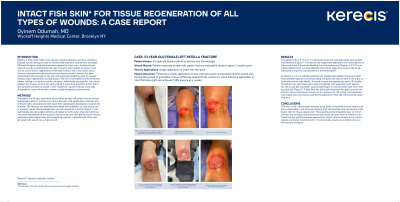Case Series/Study
(CS-107) Intact Fish Skin* For Tissue Regeneration of All Types of Wounds: A Case Report

Millions of Americans suffer from wounds caused by diabetes and other conditions. Delayed wound healing can lead to infection, debridements, amputations, and death. Fish skin when grafted to human tissue acts as a scaffold for regeneration of the body’s cells to form new human tissue. Additionally, because this is a natural product, the chances of infection with grafting is lower than prosthetic grafts. In this report, we highlight one of the remarkable outcomes fish skin grafts have had on a patient with a chronic wound.
Methods:
The patient is a 53 year old female who suffered an open left patella fracture and patella tendon rupture 7 months ago. She underwent a left patella open reduction and internal fixation and patella tendon repair then subsequently developed a surgical site infection. The infection was debrided and treated with antibiotics, but never properly healed. She developed skin necrosis, ulceration, & eschar. She had multiple excisional debridements until about 3 months ago when she had sharp excisional debridement of the wound & washout with fish-skin graft & wound vacuum application before being taken to the operating room for a left knee split-thickness skin graft with wound vacuum placement.
Results:
The patient had a 6.5 x 5 x 0.1 cm left knee wound with exposed patella bone, tendon, and hardware. The wound was tangentially debrided to the central portion of the wound to see if there was bleeding, but none was present. The exposed patella tendon was also debrided. The inferior edge of the wound was de-epithelialized to improve vascularization of the graft.
SurgiClose 7 x 10 cm solid was applied. The graft was hydrated using 20 cc of venous blood. One week after graft application the wound bed was better vascularized and two weeks later even more vascularized. 9 days later she had a split-thickness skin graft secured with chromic sutures and wound vacuum set to a pressure of 125 mmHg. The wound bed was healthy and well-vascularized before application of the split-thickness skin graft.
Discussion:
Fish skin is rich in Omega3 fatty acids, lipids, and protein that are known to be anti-inflammatory and aid wound healing. Fish skin promotes the recruitment of the body’s cells for tissue regeneration. These fish skin grafts have been approved for use for chronic wounds, burns, hernia repairs, and breast reconstruction1. The remarkable results are evidently shown in this case presentation.
Trademarked Items: *Kerecis™, Kerecis, Isafjordur, Iceland
References: 1. “Why Kerecis®?” Kerecis, 15 May 2023, www.kerecis.com/omega3-fishskin/.

.png)